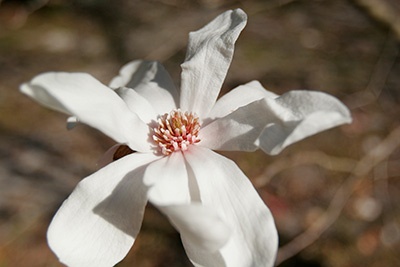Star Magnolia

The telltale sign of spring in Florida is the emergence of magnolia flowers. Although there are many popular magnolia varieties to choose from, star magnolia is an excellent pick if you live in Northwest Florida or a colder microclimate.
Star magnolia is slow growing, but the patient gardener is rewarded with excellent pest and disease resistance coupled with a spectacular show of spring blooms.
Characteristics
Native to Japan, star magnolia (Magnolia stellata) is a large shrub or small tree with a dense, round form. The lower branches can be pruned to create the standard tree form, or they can be left alone if a shrubbier form is desired. Star magnolia can reach 15 to 20 feet tall and 10 to 15 feet wide.
The leaves are green, oblong, and two to four inches long. In the fall, foliage turns shades of gold and copper. Although your tree will be leafless in the winter, this doesn’t mean it’s unattractive! If planted next to a wall or fence, putting a spotlight on it at night will create an interesting silhouette.
Once spring rolls around, flowers appear on the bare branches. Blooms are typically white to cream, with long, narrow petals that give them a frilly appearance. Other colors such as pink or purple are possible with various cultivars. Flowers are not as sensitive to cold as some other magnolias, but injury is still possible if a freeze happens during flowering.
Planting and Care

Star magnolia can be planted in USDA Hardiness Zones 5A through 8B. Consider using it as a patio plant, a small specimen tree, or as an accent shrub. This magnolia prefers locations in full sun with rich, porous, and slightly acidic soil. Keep in mind that star magnolia will not tolerate salt, drought, or root competition. Bare root plants should be transplanted in late winter when they are still dormant. Container plants can go in the ground any time of year.
There are several cultivars to choose from, depending on your preference for flower color. ‘Centennial’ produces flowers with a slight blush hue. Choose ‘Jane Platt’ or ‘Rosea’ if you want a more intense pink color. For a shade that leans purple, look for ‘Keiskei’ or ‘Rubra.’
Star magnolias rarely experience severe pest or disease problems, but there are a few you should scout for just in case. Leaf spots, blights, scabs, black mildews, canker, and verticillium wilt are all possible disease issues, although they rarely require treatment. For insect pest problems, scales and young tulip-poplar weevils are the main culprits. Keeping your tree healthy will help prevent these problems.
A note on names: Magnolia stellata is synonymous with Magnolia kobus var. stellata.
If you have any questions about cultivating star magnolia in your landscape, please contact the experts at your county Extension office.
Also on Gardening Solutions
UF/IFAS Publications
Elsewhere on the Web
- Robbie Blackhall-Miles. “Star magnolia, darling of the garden centre, threatened in the wild,” The Guardian Gardening Blog (An interesting story of M. stellata‘s name changes. Accessed 03/27/24.)
